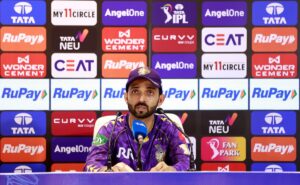
Mitchell Starc Saliva Rule IPL 2025: Australian Star Calls It a "Myth" Contradicting Mohammed Shami
Mitchell Starc Saliva Rule IPL 2025: Australian Star Calls It a “Myth” Contradicting Mohammed Shami
Table of Contents
- Mitchell Starc Saliva Rule IPL 2025: Elite Bowlers Divided
- The Controversial Statement: Why Starc Called Saliva Use a “Myth”
- Opposing Perspectives: Shami and Axar Support Traditional Methods
- The Science Behind Ball Maintenance: Does Saliva Actually Help?
- Super Over Heroics: How Starc’s Performance Supports His Claim
- Cricket Experts Weigh In: The Technical Debate
- The Evolution of Fast Bowling: Adapting Beyond Traditional Techniques
- Future Implications: How This Debate Could Shape Cricket
Mitchell Starc Saliva Rule IPL 2025: Elite Bowlers Divided
The cricket world has been set abuzz by a fascinating debate following Australian fast bowling star Mitchell Starc’s controversial stance on the reintroduced saliva rule in IPL 2025. The Mitchell Starc saliva rule IPL 2025 controversy emerged when the Delhi Capitals pacer dismissed the effectiveness of using saliva to shine cricket balls as a “myth”—a perspective that directly contradicts the views of several prominent bowlers including India’s Mohammed Shami and DC captain Axar Patel.
This unexpected disagreement among cricket’s elite has sparked intense discussion across the sport, particularly as the BCCI recently lifted the long-standing ban on using saliva for ball maintenance—a restriction first implemented during the COVID-19 pandemic as a health safety measure. The Mitchell Starc saliva rule IPL 2025 debate touches on fundamental aspects of bowling technique that have been accepted as conventional wisdom for generations.
Why The Mitchell Starc Saliva Rule IPL 2025 Debate Matters
The disagreement between elite fast bowlers about ball maintenance techniques has significant implications for cricket’s evolution. As one of the world’s premier fast bowlers, Starc’s dismissal of traditional methods challenges long-established practices and could influence future generations of bowlers, coaching techniques, and even cricket regulations regarding ball maintenance.
The Controversial Statement: Why Starc Called Saliva Use a “Myth”
The Mitchell Starc saliva rule IPL 2025 controversy began following Delhi Capitals’ thrilling Super Over victory against Rajasthan Royals, where Starc delivered a match-winning bowling performance. When questioned about his views on the reintroduction of saliva for ball maintenance, the Australian pacer provided a surprisingly dismissive response that challenges conventional cricket wisdom:
Starc’s remarks were particularly noteworthy because they came after his exceptional performance in the Super Over, where he restricted Rajasthan Royals to just 11/2 in five deliveries. This context added weight to his perspective on the Mitchell Starc saliva rule IPL 2025 debate, as it demonstrated his ability to execute elite bowling regardless of ball-maintenance techniques.
What makes Starc’s statement particularly intriguing is his distinction between red-ball and white-ball cricket. While acknowledging that saliva might impact the red ball used in Test cricket, he dismisses its effectiveness on the white ball used in limited-overs formats like the IPL—suggesting that different ball types may require different approaches to maintenance.
Opposing Perspectives: Shami and Axar Support Traditional Methods
The Mitchell Starc saliva rule IPL 2025 viewpoint stands in stark contrast to that of Mohammed Shami, one of India’s premier fast bowlers, who has been a vocal advocate for the reintroduction of saliva use. Shami had previously expressed that the prohibition on saliva was creating significant challenges for bowlers attempting to generate swing—a critical component of pace bowling strategy that can dramatically alter the trajectory of deliveries.
Similarly, Delhi Capitals captain Axar Patel has taken a position that directly contradicts his teammate Starc in the Mitchell Starc saliva rule IPL 2025 debate. As both a bowler and team leader, Patel’s perspective carries significant weight:
Mitchell Starc’s Perspective
- Considers saliva use a “myth” with minimal impact on white balls
- Draws distinction between red ball and white ball cricket
- Suggests sweat may be equally effective for maintenance
- Relies more on natural skill than traditional maintenance
- Questions the scientific basis for saliva preference
Opposing Bowlers’ Stance
- View saliva as crucial for generating swing
- Believe the COVID-era ban made bowling more difficult
- Consider it an essential tool for pace bowlers
- Advocate for bowler-friendly conditions
- See the rule reversal as restoring balance to the game
This fundamental disagreement between elite bowlers adds a fascinating layer to the Mitchell Starc saliva rule IPL 2025 discussion, highlighting how even at cricket’s highest levels, perspectives on technique can vary dramatically based on individual experience, bowling style, and adaptation to different playing conditions.
The Science Behind Ball Maintenance: Does Saliva Actually Help?
The Mitchell Starc saliva rule IPL 2025 controversy touches on fascinating aspects of cricket physics and aerodynamics. The scientific principles underlying swing bowling and ball maintenance have been studied extensively, though conclusive evidence about the superiority of saliva over sweat remains debated among sports scientists.
The Aerodynamics of Cricket Ball Swing
Cricket ball aerodynamics are influenced by the condition of the ball’s surface. Conventional cricket wisdom suggests that:
- Asymmetrical air pressure: The polished side creates different air pressure than the rough side
- Boundary layer separation: Air separates from the ball’s surface at different points on each side
- Resulting lateral force: The pressure difference generates a force that moves the ball sideways in flight
- Viscosity factors: Saliva has traditionally been believed to be more effective than sweat due to its chemical composition and viscosity
- Ball type differences: Red balls with pronounced seams may respond differently than white balls with less prominent seams
Starc’s perspective in the Mitchell Starc saliva rule IPL 2025 debate may be supported by some scientific arguments. White balls used in limited-overs cricket have different leather treatment, seam prominence, and wear patterns than red balls. The effectiveness of saliva versus sweat might indeed vary between ball types, potentially explaining Starc’s distinction between formats.
Some bowling experts suggest that modern white balls maintain their lacquer longer and are designed to minimize deterioration, potentially reducing the impact of traditional shining techniques. This technical aspect of the Mitchell Starc saliva rule IPL 2025 controversy highlights how equipment evolution might be outpacing traditional maintenance techniques.
Super Over Heroics: How Starc’s Performance Supports His Claim
What gives Starc’s perspective in the Mitchell Starc saliva rule IPL 2025 debate particular credibility is the context in which he expressed it—immediately following a masterclass in pressure bowling during the Super Over against Rajasthan Royals. In this critical match situation, Starc demonstrated exceptional skill regardless of ball maintenance methods.
| Super Over Details | Mitchell Starc’s Performance |
|---|---|
| Match | Delhi Capitals vs. Rajasthan Royals |
| Bowling Figures | 1 over, 11 runs conceded, 2 wickets |
| Key Dismissals | Two high-profile RR batsmen in pressure situation |
| Match Result | DC chased 12 runs in just 4 deliveries |
| Impact | Victory propelled DC to top of IPL 2025 points table |
This performance in a high-pressure situation gives substantial weight to Starc’s perspective in the Mitchell Starc saliva rule IPL 2025 debate. His ability to execute precision pace bowling at the highest level without relying on traditional ball maintenance techniques suggests that elite bowlers may be capable of transcending conventional requirements through sheer skill and adaptability.
Delhi Capitals’ subsequent success in chasing down the 12-run target in just four deliveries completed a victory largely attributed to Starc’s bowling excellence, further cementing his authority to speak on matters of bowling technique and ball management.
Cricket Experts Weigh In: The Technical Debate
The Mitchell Starc saliva rule IPL 2025 controversy has prompted cricket analysts and former players to offer their own insights on this divisive topic. The debate extends beyond current players to include technical coaches, commentators, and sports scientists who have studied ball movement extensively.
Survey of cricket bowling coaches and analysts on the Mitchell Starc saliva rule IPL 2025 debate shows divided opinions, though traditional views still predominate.
Former fast bowlers who have commented on the Mitchell Starc saliva rule IPL 2025 controversy highlight how bowling techniques and philosophies have evolved. Some veterans support Starc’s perspective, noting that modern bowling emphasizes variations in pace, clever use of angles, and precision yorkers over traditional swing—particularly in T20 cricket where batsmen are already primed to attack regardless of subtle movement.
However, other technical experts point out that even minimal ball movement can create dismissal opportunities at the elite level, where the margins between success and failure are incredibly small. This technical nuance adds complexity to the Mitchell Starc saliva rule IPL 2025 debate, suggesting that the importance of traditional maintenance techniques may vary based on bowling style and match situation.
The Evolution of Fast Bowling: Adapting Beyond Traditional Techniques
The Mitchell Starc saliva rule IPL 2025 controversy reflects broader evolution in fast bowling approaches. Modern pace bowlers increasingly rely on data analytics, biomechanical optimization, and tactical variations rather than traditional techniques passed down through generations.
Modern Fast Bowling Evolution
Today’s elite pacers like Starc have access to resources that previous generations lacked:
- Advanced biomechanical analysis: Optimizing action for speed and accuracy
- Pitch-mapped strategies: Data-driven approaches for different surfaces
- Variation development: Systematic training of different deliveries
- Mental performance coaching: Pressure situation preparation
- Recovery science: Maintaining peak physical condition
These modern approaches may explain why Starc places less emphasis on traditional ball maintenance in the Mitchell Starc saliva rule IPL 2025 debate, focusing instead on skill execution and tactical awareness.
Starc’s perspective suggests that elite bowlers may have developed compensatory skills during the COVID-era restrictions that have reduced their reliance on traditional methods. This adaptation could represent an important evolution in bowling technique—one where skill execution transcends traditional dependencies on ball condition.
The technical divide in the Mitchell Starc saliva rule IPL 2025 controversy might also reflect different bowling philosophies. Starc’s pace-first approach, which often emphasizes yorkers and rapid bouncers, may indeed be less dependent on subtle swing than other bowling styles that rely more heavily on movement through the air.
Future Implications: How This Debate Could Shape Cricket
As the IPL 2025 progresses, the Mitchell Starc saliva rule IPL 2025 debate could have lasting implications for cricket’s technical evolution. Performance statistics in the tournament may provide empirical evidence regarding the effectiveness of different ball maintenance approaches.
Potential Long-Term Impact
The Mitchell Starc saliva rule IPL 2025 controversy could influence several aspects of cricket’s future:
- Coaching techniques: How young bowlers are trained in ball maintenance
- Rule development: Future regulations regarding ball condition and maintenance
- Equipment evolution: Ball manufacturing techniques and materials
- Tactical approaches: Team strategies regarding bowling rotations and match-ups
- Scientific research: Further studies on the physics of ball movement
The divergent views exposed in the Mitchell Starc saliva rule IPL 2025 debate highlight cricket’s ongoing evolution, where traditional practices are continuously evaluated against modern insights and approaches. While some bowlers rely heavily on conventional techniques for ball maintenance, others like Starc appear to have adapted their skills to be effective regardless of such factors.
This technical controversy ultimately reflects the rich complexity of cricket, where nuances in approach, personal preference, and evolving techniques continue to shape the sport’s development. The Mitchell Starc saliva rule IPL 2025 debate serves as a fascinating case study in how even the sport’s fundamental technical aspects remain open to interpretation and evolution at the highest levels of performance.
As cricket continues to evolve, the tension between tradition and innovation highlighted by this controversy will likely influence how future generations approach the art of fast bowling—with potentially significant implications for the balance between bat and ball in the world’s second most popular sport.






